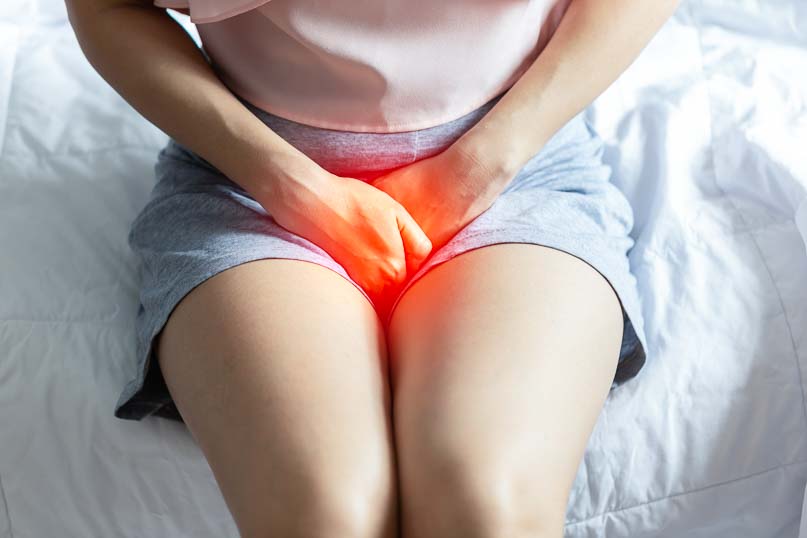Pelvic pain in women is a complex and multifaceted condition that can significantly impact quality of life. This pain can range in intensity from mild discomfort to sharp, debilitating pain. It can be constant or intermittent, and in some cases, it is associated with certain activities such as sexual intercourse, urination, or menstruation.
This pain is not a disease in itself but a symptom indicating that something else is happening in the body. It can have multiple causes, including gynecological, urinary, digestive, or even muscular issues. Understanding the origin of pelvic pain is crucial for finding the right treatment.
Below, we will explore some of the most common disorders associated with pelvic pain, such as dyspareunia, vaginismus, vulvodynia, and endometriosis, and discuss how pelvic floor physiotherapy can be an effective tool in managing these conditions.
What are the Different Type of Pelvic Pain?
1. Dyspareunia: Pain During Sexual Intercourse
Dyspareunia refers to recurrent or persistent genital pain that occurs before, during, or after sexual intercourse. This condition can be superficial or deep and can have multiple causes, including infections, inflammation, dermatological conditions, or musculoskeletal dysfunctions. The pain can lead to a significant reduction in quality of life, affecting both the physical and emotional health of the woman.
Managing dyspareunia often requires a multidisciplinary approach, where women’s health Physio plays a crucial role. Through techniques such as postural education, biofeedback, and manual therapy, muscle tension can be reduced, blood circulation improved, and the flexibility of the pelvic floor muscles increased, which can alleviate pain symptoms.
2. Vaginismus: Involuntary Contraction of Vaginal Muscles
Vaginismus is a condition characterized by the involuntary contraction of the pelvic floor muscles, making vaginal penetration difficult or impossible. This reflex contraction can be triggered by emotional, psychological, or physical factors and may be associated with fear of pain, traumatic sexual experiences, or deeply rooted cultural and religious beliefs.
Treating vaginismus involves cognitive-behavioral therapy to address emotional factors and Women’s Health physiotherapy to treat the physical components of the disorder. Through muscle relaxation exercises, breathing techniques, and the use of vaginal dilators under the guidance of a specialized physiotherapist, women can learn to control the involuntary contraction and reduce pain during penetration.
3. Vulvodynia: Chronic Vulvar Pain
Vulvodynia is chronic vulvar pain that lasts for at least three months without an identifiable cause. This pain can be constant or intermittent and may present as burning, stinging, irritation, or stabbing sensations, making everyday activities like sitting or wearing tight clothing uncomfortable.
The exact causes of vulvodynia are not fully understood but are believed to include neurological, hormonal, immunological, and psychosocial factors.
Managing vulvodynia is equally complex and may include pharmacological, psychological, and physiotherapeutic treatments. Women’s Health Physiotherapy can be particularly beneficial in this context, using techniques such as soft tissue mobilization, myofascial release, and postural re-education to alleviate pain and improve function.
4. Other Disorders Related to Pelvic Pain
In addition to the disorders mentioned, pelvic pain in women may be related to other conditions such as endometriosis, irritable bowel syndrome, recurrent urinary tract infections, and pelvic floor dysfunction. In many cases, these conditions coexist, complicating diagnosis and treatment.
Women’s Health physiotherapy can also be beneficial for these conditions, helping to improve muscle function, reduce tension and pain, and enhance the patient’s quality of life. For example, in the case of endometriosis, one of the most common causes of chronic pelvic pain, physiotherapy can help reduce the stiffness of scar tissue and improve the mobility of pelvic organs.

How Women’s Health Physio Treats Pelvic Pain?
Now that we have a better understanding of what pelvic pain is and its common causes, it’s time to talk about how it can be treated. One of the most effective approaches is the treatment of pelvic pain with pelvic floor physiotherapy. This specialty focuses on evaluating and treating the pelvic floor muscles, which play a crucial role in many bodily functions, including supporting the pelvic organs, urination, defecation, and sexual function.
Physiotherapeutic treatment is tailored to the specific needs of each patient and may include:
- Strengthening and Stretching Exercises: To improve muscle function and reduce tension.
- Manual Therapy: Including techniques such as soft tissue mobilization and myofascial release to relieve pain and improve mobility.
- Biofeedback: To help the patient become aware of and learn to control their pelvic floor muscles.
- Postural and Ergonomic Education: To improve posture and reduce overload on pelvic muscles.
- Cognitive-Behavioral Therapy: In collaboration with psychotherapists, to address the emotional and psychological factors that may be contributing to the pain.
This type of treatment not only addresses the symptoms of pelvic pain but also treats the underlying causes. By improving muscle function and posture, many women experience significant pain relief as well as an improvement in their quality of life.
Furthermore, this approach is non-invasive and personalized, meaning it is adapted to the specific needs of each woman, whether she is dealing with dyspareunia, vaginismus, vulvodynia, or endometriosis.
Pelvic Floor Pain in Summary
Pelvic pain in women is a condition that requires a comprehensive and multidisciplinary approach for effective management, as it is a complex symptom that can have a profound impact on daily life. Conditions such as dyspareunia, vaginismus, and vulvodynia not only have a physical impact but also an emotional and psychological impact on patients. Women’s Health Physio emerges as an essential tool in treating these conditions, offering a non-invasive option that can significantly improve the quality of life for women suffering from pelvic pain and help to live a life free from pain.



